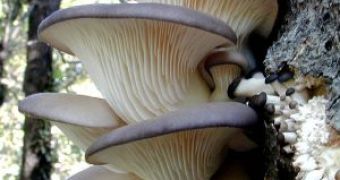An international team composed of scientists from nineteen universities and research centers from Europe, Canada, Japan, Israel and the United States and lead by Antonio Gerardo Pisabarro de Lucas, Microbiology Professor at the Public University of Navarre, sequences for the first time the genome of an edible mushroom, the oyster mushroom.
The oyster mushroom (Pleurotus ostreatus) has a high nutritional value (it contains high levels of vitamins, proteins and non saturated fatty acids) being grown on an industrial scale and appear to reduce cholesterol levels and has been attributed anticancer properties but it also has applications in the manufacture of paper pulp and cosmetics. It is also a model for studying the CO2 cycle - the main greenhouse effect gas- and has a great potential for use in biodegradation of contaminants.
The mushroom is actively involved in the re-circulation of carbon at a global level because it is an active lignin-degrader. Lignin is the second most abundant biopolymer on Earth, after cellulose, found in wood and grassy plants, and its breakdown is a necessary for making cellulose accessible to degradation which could lead eventually to biofuel.
The understanding the genome regulation of P. ostreatus lignocellulolytic enzymes would help the use of the mushroom in biodegradation processes and other biotechnological processes. Lignin has a chemical composition that is not easy to break down - similar to some of the contaminant compounds that man releases into the environment, such as certain colorants or oils and by-products of the timber industry such as pulp and paper.
Thus, the study of the functioning of the oyster mushroom and of its strategies for adapting to its growth environment and for degrading lignin may be used for designing systems to enable the elimination of these contaminants from the environment. P. ostreatus is a saprophyte in the wild (it lives on dead or decaying matter).
The comparison of its genome with that of other saprophytic and pathogenic basidiomycetes (mushrooms) would help in identifying specific gene sets for these different lifestyles.
Oyster mushroom is the third in the worldwide market of industrially produced mushrooms. The study of its genetic organization can give pointers to what is needed for many mushrooms not industrially grown in order for them to be produced as industrial crops, such as, for example, Boletus aereus. It can grow easily on a variety of organic substrates, including agricultural wastes, recycling them for animal foodstuff.
More knowledge about the genetic back-up of these properties will facilitate the expansion of the range of agricultural wastes amenable to conversion using this fungus. P. ostreatus also produces various secondary metabolites of medical interest, whose production could be improved.
University of Navarre has been working with the genetic material of the oyster mushroom since 1994. Till now 350,000 "letters" ( nucleotidic bases) were sequenced (1% of the total genome), helping to estimate the number of genes and their organization. That means 100 genes (of a total of 10,000) were isolated and studied.
Sang-Kyu Park, a PhD student at the University of Navarre, studied their pattern of expression throughout development and their location on the fungus genome. A number of genes controlling growth rate and quality have been identified in P. ostreatus, but till now, he did not find which genes reduce cholesterol or which have anticancer properties.
Some of the discovered genes participate in the metabolism and others in the cell structure of the oyster mushroom. There are genes that only express themselves in the mature fungus, while others express themselves both in the spores and in the mycelium, etc. It was seen that the genes distribution is not uniform along the genome, given that the XI chromosome, the smallest in size, is the one containing the greatest number of genes.
The complete genome for the oyster mushroom has 70 million nucleotidic bases, in double copies, because the fungus is diploid (having a double number of chromosomes, like animals and evolved plants).
In fact, sequencing the complete genome involves the handling of 280 million bases, because each one of the two sets of genes has to be read several times to be sure that there are no errors in what has been read. The real task now is to determine where genes starts and finishes, what they do and how they do it.
Comparison of the mushroom's genome with other histories registered in other genomes that have been - or are currently being - sequenced (human, animal, vegetable and microbian) will shed a new light on the image of the evolution of life.
The project needs two years to be completed.

 14 DAY TRIAL //
14 DAY TRIAL //